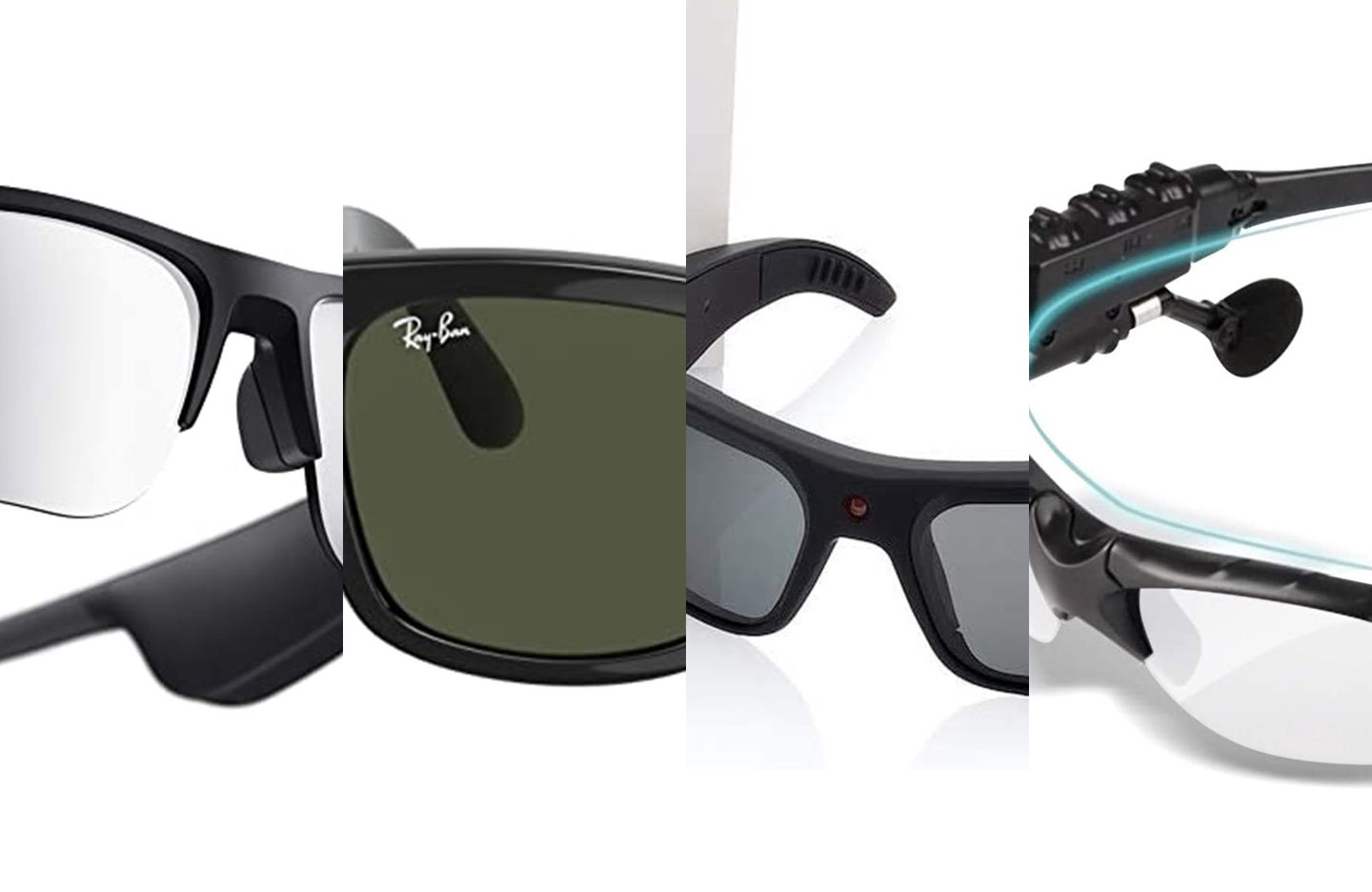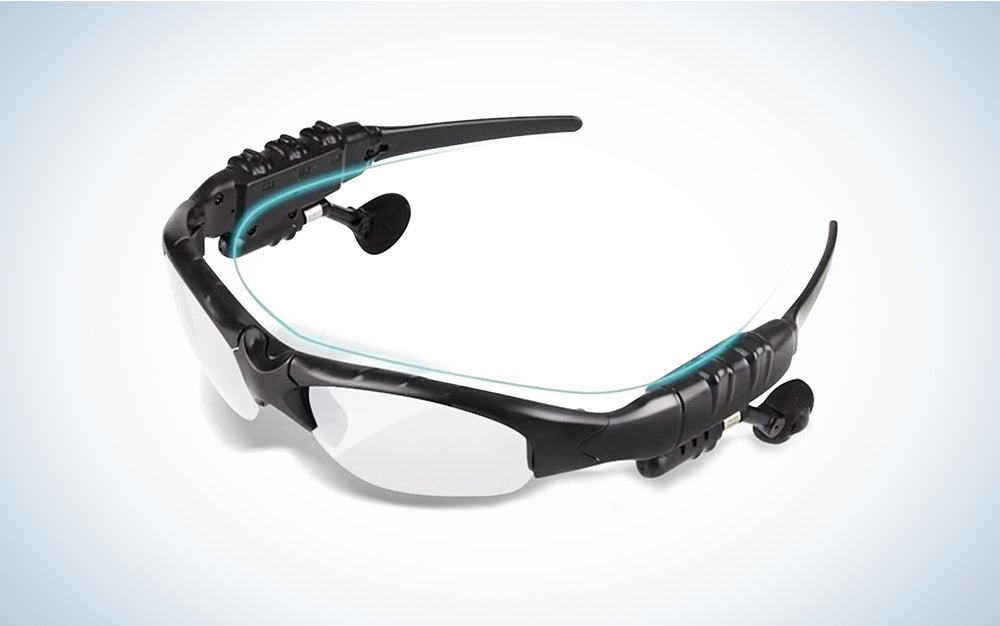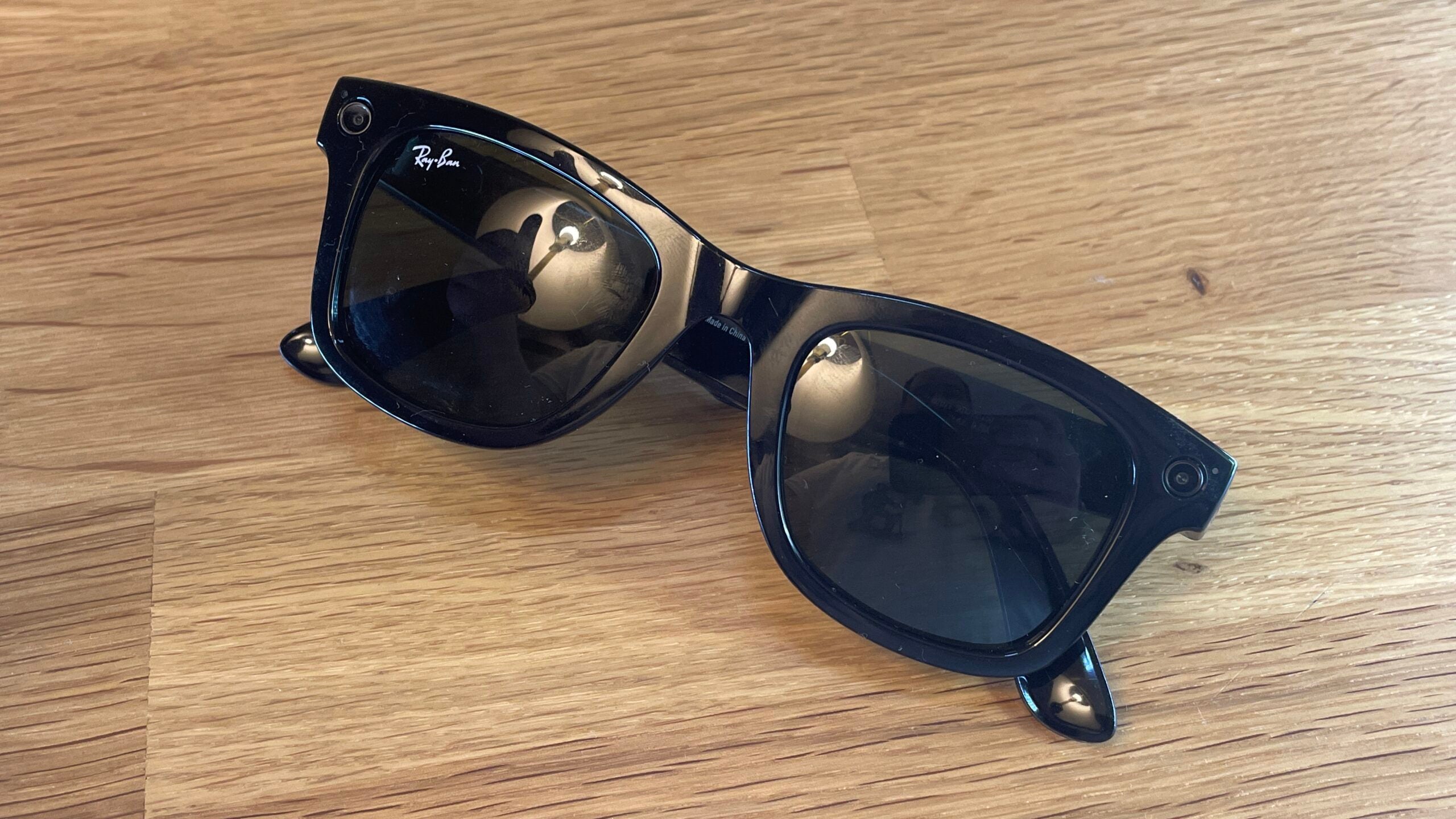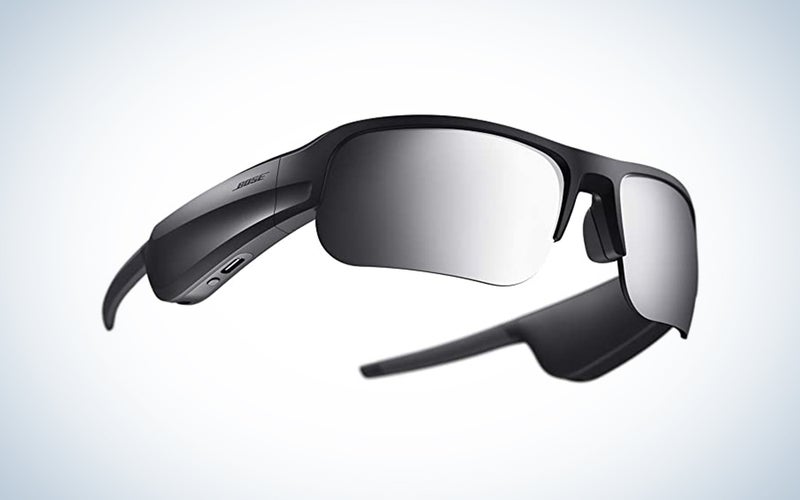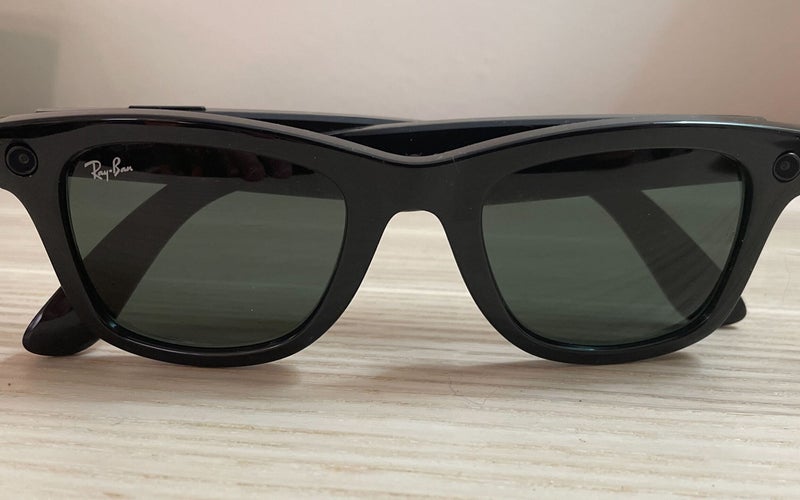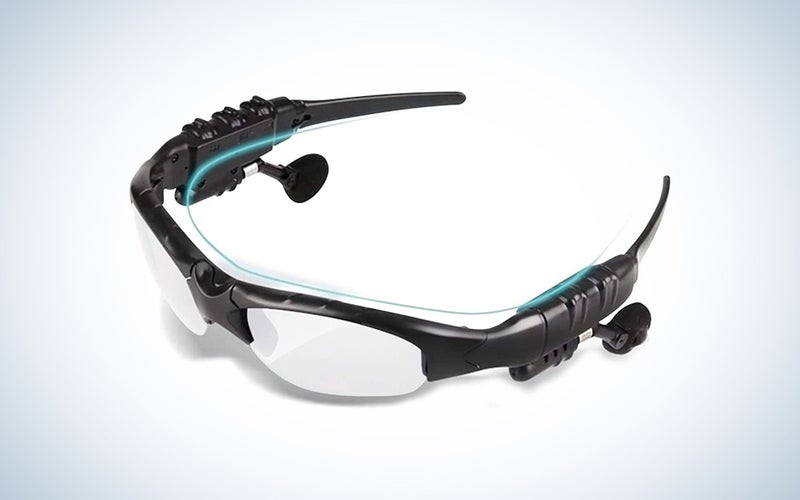We may earn revenue from the products available on this page and participate in affiliate programs. Learn more ›
Phones, watches, TVs—they can make anything smart these days, even glasses! We may not have flying cars yet but we can live out our cyborg fantasies with high-tech glasses that take pictures and video, let us talk to our digital assistants hands-free, and more! They can still be a fun tech toy for early adopters or a life-changing accessibility tool. The expectations of what “smart glasses” can and/or should do haven’t quite crystallized yet, so the capabilities they offer vary widely—as do their price tags. That’s why we’re here to help you navigate the market to find the best smart glasses for your particular needs and budget.
- Best overall: Bose Frames Tempo
- Best for social media: Ray-Ban Stories
- Best budget: TechKen Sunglasses
How we chose the best smart glasses
The smart glasses space is still taking shape, so it’s hard to say what glasses are universally “the best.” Judging glasses with AR functionality requires a different approach than judging glasses that play music and take pictures. To cover the gamut fairly, we’ve divided our selections by their strengths, whether you want to listen to music, record videos, post to social media, etc. We looked for smart glasses that were well-reviewed by both consumers and professionals and, as much as possible, came from manufacturers with proven track records for delivering resilient and comparably sophisticated consumer tech.
The best smart glasses: Reviews & Recommendations
Although most smart glasses fall short of the dream established by Google Glass nearly a decade ago—repackaging functions from our phones and earbuds into a new form—there are still standouts that marry fun and function. If you’re looking to get on the start of the smart glasses wave, you’ve come to the right place. We’ve compiled the cream of the crop to help you find the perfect pair of cutting-edge smart specs, no matter your needs or budget.
Best overall: Bose Frames Tempo
Bose
Buy it used or refurbished: eBay
Why it made the cut: Bose Frames Tempo sounds better than any other smart glasses out there.
Specs
- Lens: Polarized in various colors (prescription options available)
- Battery: 8 hours play time, 1 hour charge time
- Camera: N/A
- Audio: Open-ear
- Microphone: 2 mic array
- Connectivity: Bluetooth
- Water resistance: IPX4
Pros
- Clear speakers
- Excellent microphone
- Intuitive controls
- Long battery life
Cons
- Expensive
- Tight on large heads
Bose has been a leader in the American audio industry since the 1960s, and its take on smart glasses, the Bose Frames, lives up to that legacy with the highest-quality speakers and microphone array available in a pair of shades. Bose makes three second-generation variations on the Frames—Tenor, Soprano, and Tempo—with varying styles and specs. We recommend the Tempo, the athletic style, out of the three because it has the best speakers, gets longer battery life, and charges by generic USB-C, rather than a proprietary cable. That said, the other models are close enough to the Tempo in overall quality that you shouldn’t be afraid to pick the glasses that fit your style.
Best for social media: Ray-Ban Stories
Mike Epstein
Buy it used or refurbished: eBay
Why it made the cut: Meta wisely partnered with a company that understands the “glasses” part of smart glasses.
Specs
- Lens: Colors, blue light, non-polarized, UV-protection, transitions (prescription options available)
- Battery: 3 hours use, 1 hour to charge
- Camera: 5MP sensor, up to 1414 x 1414p/30fps video, up to 2592 x 1944p stills
- Audio: Open-ear
- Microphone: 3 mic array
- Connectivity: Bluetooth
- Water resistance: N/A
Pros
- Classic Ray-Ban style
- Great speakers and call quality
- Charging case
- Easy controls
Cons
- Require Facebook account
Facebook/Meta is an obvious tech vertical stakeholder for smart glasses, whether they take photos or deliver the “metaverse” via AR. For its first foray into smart glasses, it teamed up with Ray-Ban to create a stylish pair of shades that people will want to wear. The Ray-Ban Stories come in various styles, including the iconic Wayfarers, with prescriptions available. The photo/video camera controls are intuitive both on the frames or with voice commands. The main downside is that you need to have a Facebook account to use them, even though you don’t have to funnel the pictures through Facebook or Instagram. As we noted in our full review, that connection may leave some people conflicted. In the end, though, they’re solid, sharp-looking shades with both audio and camera functionality.
Best budget: TechKen Sunglasses
TechKen
Why it made the cut: The TechKen Sunglasses are a bargain-basement pair of smart sporting sunglasses for when you just need the basics.
Specs
- Lens: Colors, clear, polarized (no prescription options)
- Battery: 7-9 hours use, 2 hours charge time
- Video: N/A
- Audio: Earbuds
- Microphone: Yes
- Connectivity: Bluetooth
- Water resistance: N/A
Pros
- Inexpensive
- Built-in earbuds and microphone
- Great battery life
Cons
- Minimal smart features
- Cheap construction
TechKen’s Sunglasses are the least “smart” of the glasses on our list. They’re effectively just a pair of Bluetooth earbuds and a microphone built into a pair of sports sunglasses and no other intelligent features to speak of. Then again, they cost $16 versus $100-$300 for any option from a major manufacturer. Earbuds tend to fall out, and headphones conflict with helmets or hats, so these can be a great way to listen to music or podcasts and take hands-free calls while having outdoor adventures without worrying that you’ll lose an expensive wireless earbud.
What to consider when buying the best smart glasses
Right now, most smart glasses feature conventional eyeglass or sunglass lenses with some combination of cameras, microphones, and speakers built into the frames, offloading the core features of your smartphone into a wearable device you can operate without reaching into your pocket. And they connect to your phone via Bluetooth, just like an Apple Watch, etc. You might think of them as a more casual alternative to a pair of wireless headphones—they play music and let you take phone calls, but without blocking the outside world.
The more advanced version(s) of smart glasses—those that support augmented reality—technically exist but are highly niche products with very limited functionality. Unless you’re an AR developer, you will probably have more fun with the speakers and cameras.
Open-ear audio and bone conduction
Almost all of our current picks that have audio playback (besides the budget option with attached earbuds) use “open-ear audio.” Rather than covering or inserting something into the ear, these glasses have little speakers built into the frames that point down toward your ears, playing music that you can hear clearly while allowing you to maintain awareness of your surroundings.
Some smart glasses avoid speakers altogether and use bone-conduction technology, which transmits audio through direct vibrations onto your facial bones, rather than through the air as sound waves. Directional speakers seem to be more common at the moment since they sound a bit clearer, with the caveat that some of their sound bleeds to your surroundings. By contrast, bone conduction sounds slightly less clear but is extremely discreet. Do not, however, set your expectations for audio quality especially high in either case. Smart glasses are optimized for convenience and comfort, not high-fidelity sound.
Battery life and storage
Whatever your smart glasses do, their battery life informs how long they’ll be able to do it. Consider how long you hope to be out and about taking pictures and calls without needing to plug your glasses in. Likewise, most smart glasses have very limited internal storage. You will need to wirelessly offload your photos and videos from your glasses to your phone regularly to keep its hard drive clear, as well as edit, caption, and post anything you take.
Water resistance
Since smart glasses pack delicate electronics into the frames, they are usually rated for some amount of protection against water and dust. The standard maintained by the International Electrotechnical Commission, or IEC, is called an IP rating, which is short for “Ingress Protection.” The water/dust resistance rating features two numbers, which you’ll see on a spec sheet as part of an IP rating—“IPXX.” The first X is a score from 0 to 6, measuring how well it keeps out solids—dust, sand, etc. The second, rated between 0 and 9, indicates how well it keeps out liquids. An X left in either spot means that the product was not tested for that resistance, respectively.
Every pair of glasses on our list maxes out either number at “4” ratings, which translates to protection against physical objects larger than 1mm and against splashing liquids but not being submerged. That seems to be the current standard, though there are exceptions. For example, the Snapchat Spectacles 2 featured IPX7 protection, allowing shallow immersion to take underwater pics, but that capability was removed for the next iteration.
State of the AR(t)
If this is your first foray into the smart glasses space, you might have some lofty expectations about the current state of augmented reality (AR), which you’ll need to temper. AR glasses are still too new, complicated, and expensive for wide consumer use. Names you may have heard like the Microsoft Hololens 2 start at $3,500, as they’re designed for research and industrial applications, not laying out Google Maps directions on the street in front of you. We’ve included one option on our list, the Vuzix Blade, which splits the difference between function and cost better than most for the most enthusiastic early adopters. For the rest of us, true AR is still on the backburner.
Don’t forget: They’re also glasses!
Many people need their smart glasses to also function as regular old eyewear that provides vision correction on top of their onboard A/V suite. Some manufacturers offer the ability to purchase glasses with prescription options upfront. Others require you to find and purchase your own after-market lenses (which we will note below). Either way, be prepared to pay significantly more money for a pair of smart glasses with your prescription.
FAQs
Q: How much do smart glasses cost?
The range of what people call smart glasses is still extremely wide. Right now, our list ranges from roughly $16 to $1,000. That said, the majority of smart glasses with speakers and/or a camera generally cost between $150 and $300.
Q: What are smart glasses used for?
Smart glasses typically pair to a smartphone over Bluetooth, operating as a headset with built-in speakers and a microphone for taking calls and using a digital assistant. Some also feature cameras built into the frames, allowing you to record pictures and video. There are also a very small number of AR-enabled smart glasses, which overlay images into your field of view, but they are the exception, not the rule.
Q: What is the battery life of smart glasses?
Battery life also varies quite widely among smart glasses. Even within a given pair can vary quite a bit, depending on how heavily you use them. At a minimum, most smart glasses allow at least an hour of active use but ideally last a few hours. In general, you should expect that recording video on a pair of smart glasses will drain their battery more quickly than listening using their audio features.
Final thoughts on the best smart glasses
- Best overall: Bose Frames Tempo
- Best for social media: Ray-Ban Stories
- Best budget: TechKen Sunglasses
Smart glasses are still a new form of technology, which makes this an exciting time to get into them. Each new iteration has the potential to make massive functional improvements over the last. Whether you just want to more conveniently listen to music on the go, or you’re excited about the posthuman future of technological enhancement, there’s probably a pair of smart glasses out there for you, or there will be soon.
Why trust us
Popular Science started writing about technology more than 150 years ago. There was no such thing as “gadget writing” when we published our first issue in 1872, but if there was, our mission to demystify the world of innovation for everyday readers means we would have been all over it. Here in the present, PopSci is fully committed to helping readers navigate the increasingly intimidating array of devices on the market right now.
Our writers and editors have combined decades of experience covering and reviewing consumer electronics. We each have our own obsessive specialties—from high-end audio to video games to cameras and beyond—but when we’re reviewing devices outside of our immediate wheelhouses, we do our best to seek out trustworthy voices and opinions to help guide people to the very best recommendations. We know we don’t know everything, but we’re excited to live through the analysis paralysis that internet shopping can spur so readers don’t have to.
